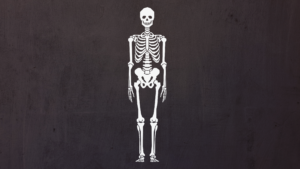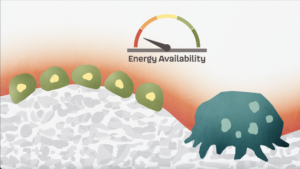All About Bone Stress Injuries (BSIs)
All About Bone Stress Injuries (BSIs)
Blog by: Ellie Diamond, FASTR Research Coordinator

Strong bones are a main ingredient when it comes to cooking up the lifelong athlete dish for big, exciting, and sometimes scary goals. Building and maintaining strong and healthy bones helps our bodies to do all of the activities we love.
What is a Bone Stress Injury?

Your bones are built to withstand the impacts of daily movement. However, too much strain without adequate time and fuel to repair and rebuild can negatively impact bone health.
When your bones are unable to properly *remodel to tolerate repetitive mechanical loading from activities like running, a bone stress injury (BSI) can occur. BSIs can vary in level of severity from a bone stress reaction, to a complete bone fracture. A bone stress reaction means that the bone has been injured. A stress fracture is when there is a fracture line present in the bone. The level of severity can increase if the injury is not addressed.
These injuries can affect athletes across all sports and all ages. However, some sports see higher rates of BSIs such as running, gymnastics, and rowing. For instance, BSI rates in runners can reach up to 20% per year. (Fredericson et al, 2016).Common sites include the lower legs like the tibia (shin bone), fibula (long bone next to the tibia), metatarsals (toes), and calcaneus (heel).
The More You Know – BSI Risk Factors & Prevention
Having knowledge about a topic allows us to be properly informed and calculated in the decisions we make. To be able to best prevent bone stress injuries, we want you to be armed with as much information as possible. There are biological, biomechanical, and numerous other risk factors associated with bone stress injuries.
Biological Risk Factors & Prevention
Biological factors can include aspects of how your bodies function and what makes them unique like brain chemistry, genetics, gender, hormones, and nutrition. Females are at greater risk for BSIs than males (Rudolph et al, 2021). Out of these risk factors, hormones and nutrition are the most modifiable.
- Nutrition and Hormones: Linking Low Energy Availability to The Female Athlete Triad and RED-S.
- Calcium and Vitamin D
- Nutrition
Your nutrition practices and intake of fuel (food) can have a major impact on your health in sport and life. As we know, the foundation of the *Female Athlete Triad and RED-S* is low energy availability. Without enough energy in (food) to match, or exceed energy expended (exercise), your body reacts by suppressing the natural hormone balance in the body. This can lead to a number of consequences like the loss of a period, weakened immune system, and decreased bone health.

Calcium and vitamin D are two main nutrients that help to keep bones healthy and strong enough to respond to typical movement loads AND facilitate bone repair and regrowth.
Calcium is an essential building block for your skeletal system. Some great food sources of calcium include yogurt, cheese, beans, and lentils.
Vitamin D is also incredibly important when thinking about creating and maintaining strong bones. Vitamin D and calcium work together as Vitamin D helps absorb the calcium from food. Some Vitamin D rich foods include oily fish, eggs, dairy, and mushrooms.
While Calcium and Vitamin D are very important to bone health specifically, it is important to emphasize the fact that a full, well-balanced diet is also key to bone and overall health in the female athlete.
Nutrition plays a huge role in how we feel and perform. It can also be overwhelming to know how to optimize your nutrition. For specific nutrition needs and questions, seek support from a Registered Dietician. These individuals are experts in their field and can help guide your nutrition so you can meet (and exceed) athletic goals.
Biomechanical Risk Factors & Prevention
Biomechanical factors can be thought of as the way your body moves, the repetitive motions it makes, and the internal and external forces that can put stress on the body.
- Volume & Intensity (Risk Factor)
- Movement in Adolescence (Prevention)
- Strength Training (Prevention)
When thinking about bone stress injuries, biomechanical risks to consider are your training patterns like volume or intensity changes. When you ramp up training too quickly by adding more time to your training or more intensity, your bones may not be able to adapt quickly enough.
Studies show that involvement in sports with multidirectional and cutting movements, like ball sports, during adolescence, a time when your bones are growing and developing the most, is beneficial to skeletal health and the prevention of future BSIs. Soccer is an example of a sport that requires these multidirectional movement patterns.
Similarly, participating in weight training and plyometric exercises can help your bones grow and get stronger. This type of loading, alongside proper nutrition and rest, provides the stimuli to facilitate healthy bone building.
Learn More
Bone health is just one piece of the female athlete health puzzle. All the pieces that come together to optimize your overall health and performance are linked very closely together. Your nutrition intake can impact your hormones, which can impact your bone health, and on and on. Staying informed about how your body works will help you know ways to feel and perform your best for the long run. To read and watch more on bone health and the female athlete check out the Australian Institute for Sport’s information on bone health and BSI’s. Check it out!
Sources:
Fredericson, M. , Jennings, F. , Beaulieu, C. & Matheson, G. O. (2006). Stress Fractures in Athletes. Topics in Magnetic Resonance Imaging, 17 (5), 309-325. doi: 10.1097/RMR.0b013e3180421c8c.
Hughes JM, Dickin DC, Wang H. The relationships between multiaxial loading history and tibial strains during load carriage. J Sci Med Sport. 2019 Jan;22(1):48-53. doi: 10.1016/j.jsams.2018.05.026. Epub 2018 Jun 1. PMID: 29884594.
Ruddick GK, Lovell GA, Drew MK, Fallon KE. Epidemiology of bone stress injuries in Australian high performance athletes: A retrospective cohort study. J Sci Med Sport. 2019 Oct;22(10):1114-1118. doi: 10.1016/j.jsams.2019.06.008. Epub 2019 Jun 29. PMID: 31307905.
RUDOLPH, S. , CAKSA, S. , GEHMAN, S. , GARRAHAN, M. , HUGHES, J. , TENFORDE, A. , ACKERMAN, K. , BOUXSEIN, M. & POPP, K. (2021). Physical Activity, Menstrual History, and Bone Microarchitecture in Female Athletes with Multiple Bone Stress Injuries. Medicine & Science in Sports & Exercise, 53 (10), 2182-2189. doi: 10.1249/MSS.0000000000002676.
Tenforde AS, Kraus E, Fredericson M. Bone Stress Injuries in Runners. Phys Med Rehabil Clin N Am. 2016 Feb;27(1):139-49. doi: 10.1016/j.pmr.2015.08.008. PMID: 26616181.
Warden SJ, Davis IS, Fredericson M. Management and prevention of bone stress injuries in long-distance runners. J Orthop Sports Phys Ther. 2014 Oct;44(10):749-65. doi: 10.2519/jospt.2014.5334. Epub 2014 Aug 7. PMID: 25103133.
Australian Institute of Sport, http://static.ausport.gov.au/fphi/module-12/#/lessons/WP_6JG-zYZqWyOkl7SCXeKUmVkjHCgFX.



